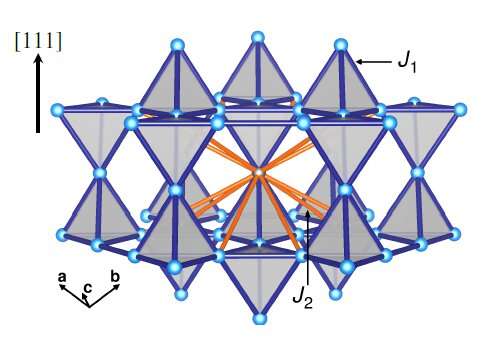New insights into magnetic quantum effects in solids

Using a new computational method, an international collaboration has succeeded for the first time in systematically investigating magnetic quantum effects in the well-known 3-D pyrochlore Heisenberg model. The surprising finding: Physical quantum phases are formed only for small spin values.
Atoms and molecules in crystalline solids are arranged in regular three-dimensional lattices. The atoms interact with each other via various forces, finally reaching a state of minimum energy. Near absolute zero, the lattice oscillations freeze, so that interactions between electron spins dominate. A particularly interesting case occurs when the spins cannot all align at the same time to reach a state of lowest energy. This results in a frustrated system in which the spins are almost completely disordered and are therefore referred to as a spin liquid.
Cubic crystal structure
One of the leading models for studying 3-D frustrated quantum magnets is the Heisenberg model on a pyrochlore lattice—a simple cubic crystal structure (see illustration). Nevertheless, it has so far been extremely difficult to derive practical predictions, i.e. for specific materials and temperatures, from this theoretical model.
Teams from Germany, Japan, Canada, and India have now jointly conducted systematic investigations of this model with the aid of a new theoretical method and solved several of these difficulties. It is possible with this new method to vary the spin value of the lattice atoms as well as the temperature and other interaction parameters, and to calculate the parameter ranges in which novel magnetic quantum effects occur. The calculations were carried out at the Leibniz Supercomputing Centre (LRZ) in Munich.
Quantum effects only for small spins
"We were able to show that quantum physical effects surprisingly only occur over very limited parameter ranges", explains theoretical physicist Prof. Johannes Reuther from the HZB, co-author of the study. These quantum effects are most pronounced at the smallest possible spin (spin value ½). However, spin systems in the crystal structure investigated by the teams already behave almost completely like classical physical systems at spin values of 1.5 and above.
The work published deepens our understanding of solids and contributes to the systematic advancement of the search for 3-D spin fluids in quantum materials.
More information: Yasir Iqbal et al, Quantum and Classical Phases of the Pyrochlore Heisenberg Model with Competing Interactions, Physical Review X (2019). DOI: 10.1103/PhysRevX.9.011005
Journal information: Physical Review X
Provided by Helmholtz Association of German Research Centres





















